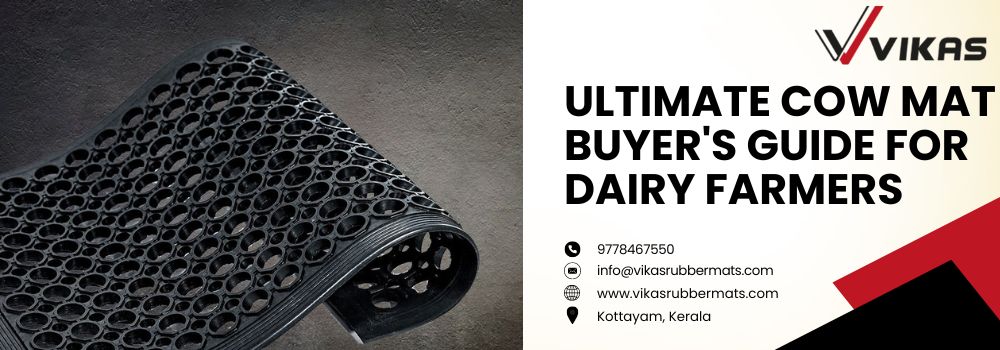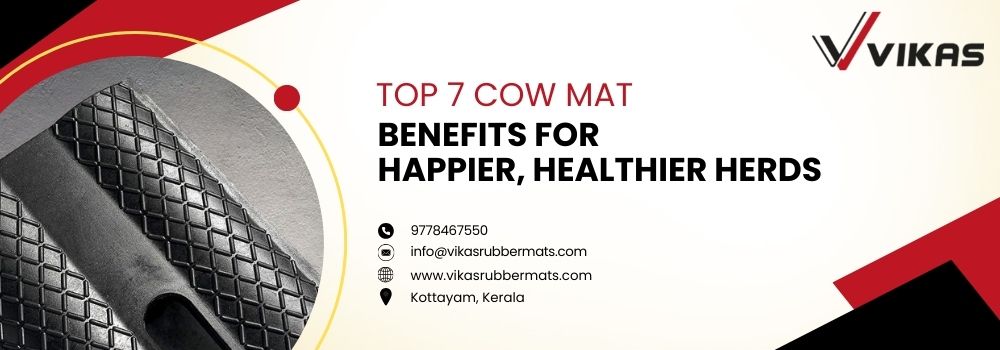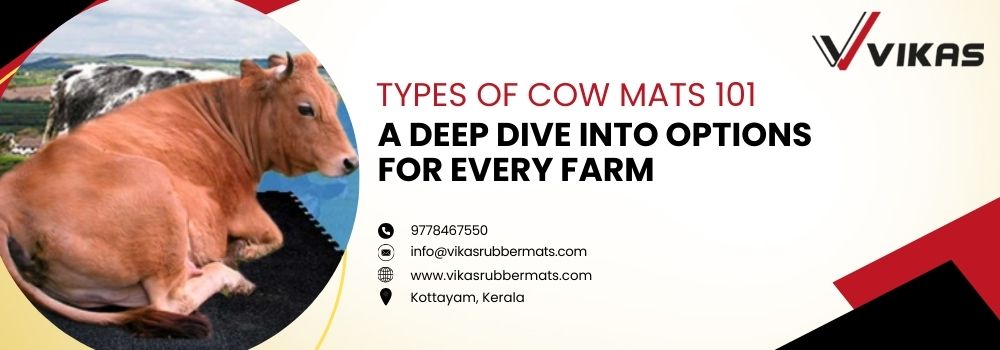
If now you're handling the business of cow farming or cattle breeding, you might have watched or heard of Cow Mats, but have you ever considered how crucial they can be for both your business and the well-being of your livestock? Cow mats are one of the essential needs for more comfortable, healthier cows and for success in cow farming. We will shed light on the profound impact on livestock comfort and productivity after using cow mats.
Dairy farming is a great source of earning, needless to mention the importance of cow mats for every individual globally. Cow products like milk, curd, ghee, cheese, etc., are used in every household, company, and factory all over the world. It is the dream of every dairy farmer to grow vigorously, provide these products in rich quantity and quality, and maximize returns to fulfil this dream. To achieve this dream, investing in solutions prioritizing cow welfare while optimizing productivity is crucial.
Cow Mats – an extreme flooring solution that can enormously impact your business profitability. From improving milk production to providing a level of comfort to cows, and reducing health issues, we analyze how these mats can recast your operation. We will uncover the secrets behind the triumph of cow mats.
Why are Cow Mats Needed?
When it comes to earning a profit from the animal business but in a humane manner, few things become more crucial than ensuring the well-being and comfort of your livestock. In cow farming, not only good health but also hygiene maintenance and regular medical checkups of cows are needed so that the people all over the world who consume cow products would not come in contact with any disease or infection. In addition, happy and healthy cows are productive ones, and that's where Cow Mats play a vital role.
Cow Mats are not just floor coverings; they are meant to protect cows from fatigue and injury that the hard ground can cause. Cow Mats, also called livestock mats or dairy mats, provide a comfy, cushioned exterior for cows to stand and lie on. These mats are generally lodged in the barn or milking parlour, where cows spend much of their time. Vikas Rubbers is one of the oldest and most renowned companies incorporated in 1977, and is a globally recognized manufacturer and exporter of high-quality rubber mats.
Market Demand
The demand for cow mats in the global market has been experiencing gradual growth in recent years due to the growing awareness among farmers about the benefits of using these mats. In 2022, the global market size of cow mats was approximately valued at USD 556.09 million and is expected to reach around 688.56 million by 2028. These mats provide a delicate surface for cows to stand on, and they reduce the risk of arthritis and joint pain. Both large and small farms globally are adopting the use of cow mats.
Some Major Regions or Countries Covered in This Report
India
United States
United Kingdom
Australia
China
Latin America (Brazil, Mexico, Colombia)
Other regions
Types of Cow Mats
Pasture Mat
Pasture mats contain multiple cells; these cells are packed with rubber crumbs of uniform size. There is a tough covering on the top of the pasture mat which works as a protection layer. CS wax coated, VRC coat, and heifer coat are the 3 top covers available in the pasture mat.
Foam or EVA Mat
Consider the density when purchasing EVA foam mats because not all foam mats are created equally. Some of them have a higher density, so they can handle the huge weights and pressure without tearing. These mats are lighter in weight as compared to rubber mats.
Rubber Mat
Cow Mats are going to be a good investment because of their long-term durability, anti-skid features, ease of cleaning, and maintaining hygiene.
Types of Rubber Mats
Three types of rubber are used in the manufacturing of rubber mats
Natural rubber
In the formation of Natural rubber mats rubber is collected from the rubber trees in the form of a sticky, milky, and white fluid called latex. through various manufacturing methods, the latex is distilled into the rubber that is ready for commercial processing.
Because of its properties of water resilience, it becomes a good insulator. expandable clothes like gym cycling and swimming clothes are made from it because it has a large stretch ratio and high solidity The environment-friendly products are made from it like tyres, padding in brakes, floor coverings, seats, airbags, etc. as natural rubber is waterproof and slip-resistant and biodegradable.
Synthetic rubber
This man-made, non-biodegradable synthetic rubber is made from petroleum byproducts that act as an alternative to natural rubber in many cases, particularly when enriched material properties are needed.
Recycled rubber
Recycled rubber is reclaimed from scrap materials mainly from used tires. Recycle rubber is used in Playground surfaces, Non-slip mats, Road surfaces and infrastructure, Vehicle mats and interiors, Hospital floors, Gardening products and equipment, etc.
Although there are many types of mats available in the market, each material has its speciality and advantage of installation, but the market size and demand for Rubber mats are greatly higher and preferable. Apart from being comfortable and long-term durability, it has other significant features like its easy-to-clean, non-skid feature, easily applicable in small and large farms, available at affordable prices, etc.
Installation of Cow Mats - A Step-by-Step Guide
After exploring the benefits of Cow Mats, here is some guidance to install them on your farm. The installation process might be different as it depends upon the type of Cow Mat you prefer to place, but a general direction is here.
Ready the Surface
If you have decided to install the cow mat, firstly ensure that the floor surface is tidied, even, swept, and mopped properly. The surface must be free from debris. Even the small irregularities in the floor can affect the effectiveness of the mats.
Measurement and Shape
Take a proper measurement and find out the correct shape of the area where you plan to lodge the Cow Mats, and then cut the mat to fit there accordingly. It is advisable to leave a little gap between the mats and the walls to adjust any expansion due to temperature changes.
Spread a Base
It will be a good idea to spread a base of sand or gravel before installing the cow mats. It will add more comfort and cushioning as well as make it more secure and effective to place the mats. It will provide additional support for the cows and balance the temperature as well.
Hook and Lock the Mats
Most Cow Mats have the feature of interlocking. It will make the mats stickier to the place, and no chance of slipping will be there. Vikas rubbers provide a variety of rubber mats, one of them is a rubber interlocking stable mat. Installing this mat gives a touch of assurance to your cows as these mats can withstand heavy weight and are non-slippery.
Edge and Finish
Make sure the corners of the mats are properly locked and cover the desired surface. If it needs to be trimmed any excess material. Ensure that the mats are ready and securely in place to leave the cows on it. There must not be any gaps or unevenness should be left.
Trial for Comfort
After the proper and secure installation, let the cows scour their new, fresh, comfy upgraded surface. They'll likely relish and appreciate it.
Best Cow Mat Manufacturer And Supplier
Vikas Rubber is the best Cow mat manufacturer and supplier especially renowned for providing the best quality rubber mats that affordable and are easy to clean and maintain. Our rubber cow mats provide a cushioned and safe surface that provides more comfort to your cows and other animals with a hygienic surface.
Our cow rubber mats are specially made for providing a comfortable surface to cows which helps to boost their milk productivity and pregnancy rate. The more the cow rests, the more she produces milk. Contact today Vikas Rubber to provide a safe and hygienic surface to your cows.
If you are a distributor, supplier, or large animal farm owner, feel free to contact us for bulk orders of high-quality natural rubber cow mats at very affordable prices. Additionally, our products are 100% recyclable, making them an environmentally friendly choice.
Some Major Countries We Export Our Cow Mats
- Ireland
- United States
- Canada
- Brazil
- United Kingdom
- Australia
- New Zealand
Download Our Product Broucher here.
Conclusion
After the relevant discussion on the different types of cow mats, it is concluded that the cow mats can give a quick transition to your farm as to the physical and mental health of your cow. Rubber mats are preferable all over the world. Vikas Rubbers provides a wide range of rubber cow mats like rubber interlocking stable mats, oil-resistant mats, diamond modular mats, rubber solid top mats, etc.
Contact today Vikas Rubbers at +91 96450 05044 or email us at info@vikasrubbermats.com.
Certification









.jpg)


